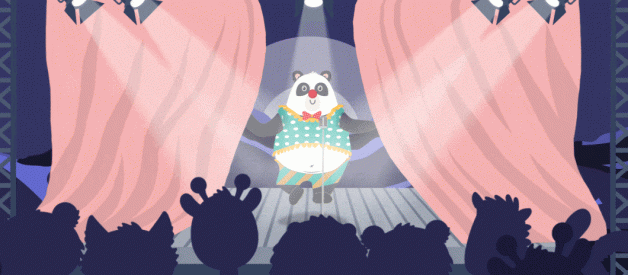What I learned about humor after analyzing dozens of comedians, from Stephen Colbert to Ali Wong
 Credit: Tomas Pueyo
Credit: Tomas Pueyo
 After giving 20 speeches at my local Toastmasters, the club for people who want to learn to speak in public, it was time for a next-level challenge. A new, harder kind of speech. I mentally ran through possibilities: Maybe I could write a persuasive speech, or give a tribute, or try my hand at storytelling.
After giving 20 speeches at my local Toastmasters, the club for people who want to learn to speak in public, it was time for a next-level challenge. A new, harder kind of speech. I mentally ran through possibilities: Maybe I could write a persuasive speech, or give a tribute, or try my hand at storytelling.
But the toughest speech I could write, I eventually realized, would be a funny one. I had always assumed people were either funny or they weren?t, and I was about as hilarious as a bundle of spinach.
Maybe I was wrong, though. Maybe I could learn to be funny. I certainly saw the value in it. A speaker can win over an audience ? of any size ? with a single funny line.
I decided to go for it. I would teach myself to be funny, the same way I?d taught myself any other skill ? by studying like mad. For months, I hid away in learning mode, analyzing the work of dozens of real and fictional comedians from Stephen Colbert to Ali Wong to Mrs. Maisel, reading articles and books about humor, and practicing.
It paid off. I participated in the Toastmasters Humorous Speech Contest in my club and won. Then I competed at the division level, and won again. Then I won for all of San Francisco, and made it to the California finals.
Here?s the video:
I?m not saying I?m the new Dave Chappelle, but I?ve been able to use what I learned to inject humor into just about all the speeches I give. And I want to share the insights I?ve found most useful. This piece is about how to craft jokes ? all the strategy, sweat, and second-guessing that goes into appearing effortlessly funny. (In another piece, I?ll include tips on how to deliver them effectively.)
Surprise your audience
Have you ever tried to just sit down and write jokes? Go on, give it a try. Whether or not you?re naturally funny, it?s awfully difficult to do, because daily humor ? the jokes and banter that flow in conversations with friends ? is very different from humor prepared for an audience of strangers. There?s no shared context, no built-in camaraderie.
So how do you do it? The easiest way is to break expectations. When you listen to someone, you?re trying not only to understand what that person is saying, but also to predict what they?re going to say next. Most of the time, your prediction is reasonably accurate.
Humor emerges when your prediction is off the mark. You can create this dissonance in your jokes with two steps: a good setup and punchline. The setup creates a specific expectation in people?s minds, and the punchline then reveals the surprise, upending the expectation.
To be a true punchline, the reveal must be short and at the very end. I didn?t understand why until I delivered my first humorous speech and told this joke:
?They love me at the NSA. Very nice people?. They listen so well!?
Crickets.
The next time I gave the speech, I changed the grammatical structure, shortening the punchline and putting it at the end.
I said, ?They love me at the NSA. Very nice people? They?re so good at? listening.?
That time, the joke landed. You can hear the laughs in the video. I realized that if your punchline is in the middle of a sentence, it gets lost because the audience is trying to listen until the end. This principle is not just important for humor, but for any kind of speech. Putting the most important point at the end increases the impact of any revelation. (Another tip: Right after the reveal, stop talking for a few seconds. You?re signaling to the audience that this point is worth thinking about.)
Of course, putting a surprise at the end of a sentence is not enough. I could tell you, ?I just ate a? car!? That?s surprising, but not funny. What else do you need for a joke?
Create a benign violation
Anybody who?s watched John Oliver or Stephen Colbert knows that criticism is funny. But why?
One reason is the surprise effect. The contrast between the persona of an upbeat humorist and their edgy criticism is impactful. If you hear Vladimir Putin make a criticism, that?s not going to be very funny. But sunny Ellen DeGeneres? That?s fun.
Another reason is that violating taboos is the essence of humor. The most recent science about humor, and the insightfully detailed in the book The Elephant in the Brain, back this up. According to authors Kevin Simler and Robin Hanson, we?ve evolved to laugh when something could be taken as serious, but we want to signal we understand it?s playful. This is why humans laugh 30 times more when they?re with others than when they?re alone.
Of course, some topics are off-limits ? for example, jokes about suffering kids or racial violence aren?t going to be funny. For a violation to contain humor, it needs to be benign. In their book The Humor Code, the behavioral scientist Peter McGraw and the writer Joel Warner describe a benign violation as one that ?says things that are true but that people avoid saying (a violation), yet not so bad that people are uncomfortable (benign).?
Finding the right balance, where most people are surprised but not hurt, is hard. Humorists need to constantly adjust their jokes based on who?s in the audience and what would surprise and offend them. An example from my speech: I stated that Germany doesn?t want to foot the bill for Greeks, and instead wants instead to have them work harder so they repay their loans, then dropped the line, ?[Germany] insists that work? makes you free.?
If you don?t know, this is a reference to Auschwitz, which had that same sentence in German hanging over its main gate. The joke was a criticism of Germany?s attitude, where again it was forcing others to work to get them to freedom. That joke got huge laughs in San Francisco, but when I delivered it in the Toastmasters finals, there was a subdued ?Ooooow.?
Reverse the expectation with double meanings
One of the easiest ways to create setups and punchlines is with double meanings ? phrases that can be interpreted in two different ways. Simply use the setup to suggest one meaning, and then the punchline to spin it in a surprising direction.
Here?s an example from Greg Dean:
?For Father?s Day, I took my father out.? (There?s the setup.)
?It only took seven shots.? (There?s punchline number one.)
?Most people don?t get their priest that drunk.? (And there?s punchline number two.)
?Took out,? ?father,? and ?shots? all have double meanings, leading to a string of funny surprises.
Use self-deprecation
Self-deprecation is one of the surest ways to get a lot of laughs. Because you?re criticizing yourself, it?s much easier for the joke to be benign. And because it?s benign, you can go much farther in the criticism, making it more aggressive and thus more surprising. Ali Wong is amazing at that. Her Netflix special, Baby Cobra, is full of self-deprecation from the very beginning, starting with: ?We are gonna have to get this shit over with, ?cause I have to pee in like 10 minutes? ?
When I?m working on self-deprecating jokes, I like to think of the advice Tyrion Lannister gave Jon Snow in Game of Thrones: ?Never forget what you are. The rest of the world will not. Wear it like armor, and it can never be used to hurt you.? Better yet, don?t wear it like armor. Make fun of it, and you?ll convert it into a weapon.
As a person who has an accent, I opened my speech like this: ?I have to tell you something. I? am not American. I know what you?re thinking: ?He?s got a perfect accent!? I hate to disappoint you, but I?m half-French, half-Spanish, fully sorry.?
Self-deprecation is not just a criticism of yourself. It doubles down as a criticism of the audience, calling out any judgmental thoughts they might have in a way that allows them to laugh at their own prejudice.
Make contextual jokes
You might call these ?you would know if you had been there? jokes. If you observe something remarkable happening during an event, you can turn that shared experience with the audience into a moment for humor.
This type of joke is hard to pull off because you need to notice something to criticize in a novel way, and you need to integrate that into your material on the fly.
You can see it in action in the pilot of The Marvelous Mrs. Maisel, where the titular comedian, Midge, wonders why the bathroom is so close to the stage.
This is a more advanced tip, but it?s almost guaranteed to make people laugh. To make contextual jokes, look around you: What?s happening? Who?s around? What are they doing? Look for something to criticize and make a joke about it.
Tag
This is one of the hardest things to do well for me. Tagging is taking a joke and insisting on it, adding new twists, getting a new laugh every time.
One of my favorite tags is from Ali Wong about HPV:
?Everybody has HPV, okay? [laughs] Everybody has it, it?s okay. Come out already. Everybody has it. If you don?t have it, yeah, you goin? get it. You goin? get it. It?s coming. If you don?t have HPV yet, you?re a fucking loser. That?s what it says about you.?
Notice how she takes a joke about HPV, and then she gets two more laughs from it. She doesn?t really change the joke much. She stays with the same concept: that HPV is widespread, and hits it repeatedly from slightly different angles. Everybody has it. If you don?t, you?re going to get it. If you don?t get it, then you?re a loser. That?s tagging.
Impersonate dialogue
Most people default to writing dialogue for a joke the way they?d write it in any other context, by reporting it: ?John said he wanted to go to the party, but Jane disagreed.?
That was definitely my first instinct, but it?s an error. It slows down the joke and reduces the rawness of the experience. You want the audience to feel like they?re in the scene.
Instead, impersonate the characters:
John said: ?Hey, hon, there?s this new expo at the MoMA tonight.?
But Jane answered: ?Is that before or after you want me to go to your mother?s??
Eddie Izzard always does a great job at it, like in his joke here about the Magnificent Seven:
Notice how every time there?s a character saying something, he impersonates the character? Just by the context, the position, and the mannerisms, you know exactly who he?s impersonating.
It might feel hard to impersonate two characters at once. Are you supposed to move and get into different positions every time you change characters? Not really. Just by shifting the pitch and body direction, you can signal to the audience that a different character is speaking.
You can see me attempting to do that during my speech. I had the advantage of using different languages to mark different people, but I also shifted positions every time I changed characters.
So you?ve spent weeks working on your speech, and you?ve peppered it with what you believe are some pretty good jokes. Ready to step out in front of an audience? Not so fast! You?re only halfway done. That?s a harsh reality of comedy: For all the work that goes into crafting your material, the delivery can make or break it. I?ll be sharing advice on how to deliver your funny speech in the next part of this series.


